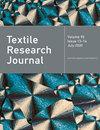Yarn-level numerical simulation based on micro-CT reconstruction for the stentering process of warp-knitted three-dimensional mesh fabric
IF 1.9
4区 工程技术
Q2 MATERIALS SCIENCE, TEXTILES
引用次数: 0
Abstract
Three-dimensional mesh fabrics of one-piece spacer structure are an essential component of automotive seat ventilation systems due to their excellent cushion and ventilation performance. The mesh structure is manufactured by stretching across the width of as-knitted structure with closed surfaces in a coupled thermo-mechanical stentering and heat-setting process. This paper presents a numerical study to examine the effect of stentering on the mesh structure and yarn architecture of a typical three-dimensional mesh fabric by establishing a finite element model based on micro X-ray computed tomography reconstruction at the yarn level. The finite element model is verified with the global and local deformation of the mesh during the stentering process. The evolution of the yarn architecture in the stentering process is demonstrated and quantitatively analyzed in terms of curvature and torsion. Three-dimensional mesh fabrics of different mesh sizes and thicknesses after stentering at different ratios are also simulated to study their compression properties. The numerical and experimental results showed that stentering opens the meshes and simultaneously shortens, widens and thins the fabric. The meshes are unevenly distributed across the width, and the intermediate meshes are more open and uniform than the two selvage meshes. To obtain a three-dimensional mesh fabric with uniform and symmetrical meshes, the as-knitted fabric should be stretched coursewise to be wider than 2 times and narrower than 2.6 times its initial width. Stentering disperses, lengthens, tilts, bends and twists the spacer monofilaments, thereby broadening the compression plateau stage and decreasing the compression resistance.基于显微 CT 重建的纱线级数值模拟,用于经编三维网眼织物的拉幅过程
一体式间隔结构的三维网眼织物具有出色的缓冲和通风性能,是汽车座椅通风系统的重要组成部分。网状结构是在热机械拉幅和热定型耦合工艺中,通过拉伸具有封闭表面的原针织结构的宽度来制造的。本文介绍了一项数值研究,通过在纱线层面建立基于微 X 射线计算机断层扫描重建的有限元模型,研究拉幅对典型三维网眼织物的网眼结构和纱线结构的影响。该有限元模型通过拉幅过程中网格的整体和局部变形进行了验证。演示了拉幅过程中纱线结构的演变,并从曲率和扭转方面进行了定量分析。此外,还模拟了不同网孔尺寸和厚度的三维网状织物在不同比率拉幅后的压缩特性。数值和实验结果表明,拉幅使网孔张开,同时使织物变短、变宽和变薄。网孔在幅宽上分布不均,中间网孔比两边网孔更开阔、更均匀。要获得网眼均匀对称的三维网眼织物,应将针织后的织物进行纵向拉伸,使其宽度大于初始宽度的 2 倍,宽度小于初始宽度的 2.6 倍。拉伸可使间隔单丝分散、延长、倾斜、弯曲和扭曲,从而扩大压缩平台阶段并降低压缩阻力。
本文章由计算机程序翻译,如有差异,请以英文原文为准。
求助全文
约1分钟内获得全文
求助全文
来源期刊

Textile Research Journal
工程技术-材料科学:纺织
CiteScore
4.00
自引率
21.70%
发文量
309
审稿时长
1.5 months
期刊介绍:
The Textile Research Journal is the leading peer reviewed Journal for textile research. It is devoted to the dissemination of fundamental, theoretical and applied scientific knowledge in materials, chemistry, manufacture and system sciences related to fibers, fibrous assemblies and textiles. The Journal serves authors and subscribers worldwide, and it is selective in accepting contributions on the basis of merit, novelty and originality.
 求助内容:
求助内容: 应助结果提醒方式:
应助结果提醒方式:


